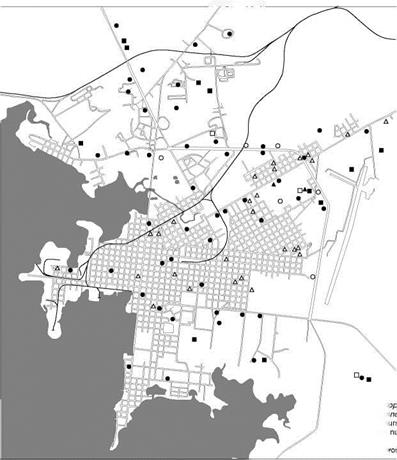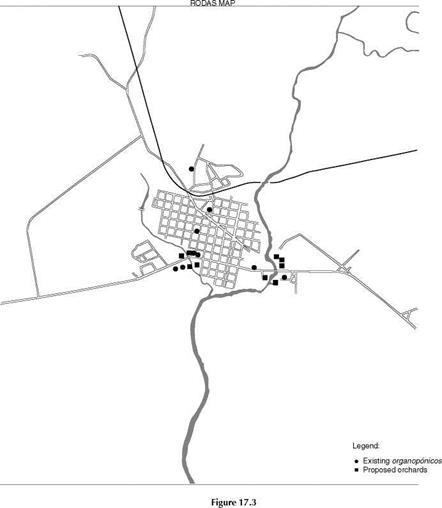Urban agriculture sites tend to be found on the urban fringe and in the city centre adjacent to major through roads, see Figure 17.1. Local conditions alter the relative distribution of urban agriculture. As density of inhabitation increases, for example as found in Havana, so city centre agriculture dimin-
|
О Urban area = Road/pathway Cuban cities can be characterised as having enfolded edges. Urban agriculture is found predominantly alongside main thoroughfares and on the urban fringe |
Figure 17.1
ishes, while the relatively low density of Cienfuegos means that urban agriculture sites are available close to the centre of the city.
Havana has a European urban character with a compact core and a less dense, at times dispersed, edge. Its historic quarter is dense and most buildings do not exceed four or five stories, squares mark urban centres and the sea provides an edge. The pattern is typical for a city that has developed over time and a number of different planning strategies are evident in its layout. In common with many
|
|
|
|
|
|
|
|

other cities, derelict plots of land in the city centre, often no larger than the footprint of a single building, have been converted into small-scale urban agriculture fields. These small plots are dispersed within the city’s historic fabric, and can be viewed as a form of agitprop advertising the city’s new means of food production, not unlike the programmes during the Second World War to convert public spaces in London to productive landscapes.
Moving out from Havana’s centre, as the city de-compacts towards its edges, larger urban agriculture sites are found, as if enfolded into the city, often adjacent to industry or new residential developments. The largest urban agriculture fields, typical examples of peri-urban agriculture, are located on the urban periphery adjacent to main access routes into the city.
Cienfuegos provides a contrast to Havana. Whereas Havana has grown incrementally, Cienfuegos is a planned city, designed by French urbanists following a strict, but generous, grid pattern. It is like a provincial version of nineteenth century Barcelona, less dense, with one – or two-storey buildings, and complete with its own version of the Ramblas. The arrangement of urban agriculture in Cienfuegos reflects its layout. Many of its plots remain undeveloped and so the grid of streets lies over the land as a matrix into which urban agriculture sites can be inserted. Relatively low urban densities and the availability of land result in an even distribution of the population and urban agriculture sites.
Notwithstanding the availability of land in Cienfuegos, strict criteria are applied before a piece of land can be designated as suitable for urban agriculture. During an interview with Hector R. Lopez Cabeza, a member of the Provincial Group for Urban Agriculture in Cienfuegos, the following selection criteria were identified:
1. Sites must be empty.
2. Sites must not have been used for any other purpose.
3. Sites should fit into a long-term plan being developed by the municipality which integrates agriculture with physical, health and hydraulic resource (water) planning.
4. Water and electricity must be available on the site and the requirements for cultivation must not adversely effect the rest of the city.
5. It is very important that sites are close to consumers so that transport requirements are minimised.
6. If any of the above criteria are not met, then sites will not be designated for urban agriculture use.
Planning guidance for urban agriculture is decided locally and in cities other than Cienfuegos it has been located on sites which have had former uses. In Rodas, for example, the La Terminal urban agriculture site is found on an old bus terminus. In these cases, where soil may be contaminated, raised beds are used and imported soil, supplemented by compost, is used for growing food crops. The reason for requiring land with no previous use, in Cienfuegos, is unclear. It may stem from a concern about contaminated land, or it may have been introduced as a way of avoiding the need to clear land of buildings and other constructions prior to establishing agriculture. The impact of these criteria is significant – in Cienfuegos 1500 hectares of open space were identified as potential urban agriculture sites, but only 50 hectares met all of the selection criteria. This small proportion of land, classified as suitable for urban agriculture, in part reflects current difficulties in Cuba related to a lack of resources; for example, difficulties extending the existing water and electricity supply network, the cost of importing soil where there is contaminated land, and difficulties transporting goods over relatively short distances. Similar difficulties are likely to be found in many cities across the world. Their impact and significance will vary with the resources available to deal with them and
|
|
the degree to which urban agriculture is being integrated into an existing city or into a planned urban expansion onto green field sites.
A major research programme investigating the practice and development of urban agriculture in Havana took place between 1995 and 1998 (Caridad Cruz and Sanchez Medina, 2003). Part of the research programme investigated land management and criteria for inserting urban agriculture into Havana. The emphasis of this research focused on articulating the benefits of urban agriculture as a legitimate urban land use. While not underplaying the technical and legal constraints on selecting sites for urban agriculture, it emphasises the need to develop coherent design strategies for its integration into the city.
Rodas has been actively perusing urban agriculture since the start of the ‘special period’ in Cuba and, apart from producing fruit and vegetables, cut flowers are also grown within the town. In 2002, the town was starting to plant communal orchards flanking the main access road and a river, which runs through Rodas. This is one of the first examples we are aware of, where urban agriculture is consciously being developed as a part a wider landscape strategy. This can be compared to
Havana’s plans in the 1960s for a green belt, and offers a micro version of a productive landscape, providing environmental and quality of life benefits.





